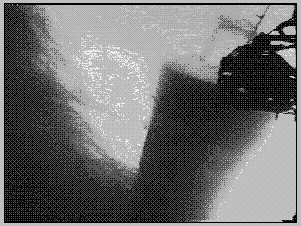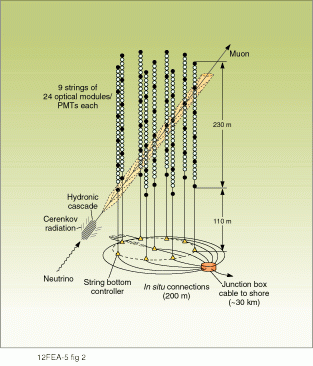|
|
|
|
The Deep Underwater Muon and Neutrino Detection ..
|
|
| DUMAND at the University of Hawaii
The Deep Underwater Muon and Neutrino Detection (DUMAND) Project existed from about 1976 through 1995. The goal was the construction of the first deep ocean high energy neutrino detector, to be placed at 4800 m depth in the Pacific Ocean off Keahole Point on the Big Island of Hawaii. Many preliminary studies were carried out, from technology to ocean optics. A prototype vertical string of instruments suspended from a special ship was employed to demonstrate the technology, and measure the cosmic ray muon flux in the deep ocean. Data from this Short Prototype String were, for example, used to set the then best limits upon PeV energy neutrinos as might be expected from Active Galactic Nuclei. A major operation took place in December 1993, at which time one string of photodetectors, a string of environmental instruments and a junction box were placed on the ocean bottom and cabled to shore. While the cable laying was successful, short circuits soon developed in the instruments and it was no longer possible to communicate with the installed apparatus. In 1995 the US DOE cancelled further efforts on DUMAND. The DUMAND goal to begin high energy neutrino astronomy is being carried forward in several ocean experiments (in order of age): NESTOR, ANTARES, and NEMO, all located in the Meditteranean Sea, as well as the venerable Lake Baikal Project in Asia, and the AMANDA/ICECUBE Project at the South Pole. The DUMAND hardware was donated to the NESTOR Project in Greece, and may yet be employed there. DUMAND institutions The DUMAND project is an international collaboration of institutions in Germany, Japan, Swiss and the US. The list of the institutions are the following, along with their emblem. Click an emblem to go to each institution's DUMAND page, if there is any. Click the name of an institution to get a list of people (clickable to go to a personal page of the person, if any) involved in DUMAND. - Germany
- Japan
- Swiss
- USA
|
|
DUMAND Picture Gallery 1 (junction box)DUMAND Junction Box at the surface
This picture was taken by an underwater video camera instrumented into a DUMAND string. Video data was digitized and sent through 30 km long DUMAND shore cable by using an optical laser. The video camera was in the string above the junction box in the normal orientation. But, we were deploying the string upside down at this time and that's why the camera is looking up the ocean surface. You can see the bottom of the ship (Thomas G. Thompson;
Univ. of Washington) in the background.
Junction Box at the Ocean floor
This is a picture taken just after the junction box had touched down the ocean floor. The video camera is looking down the junction box and ocean floor. |
|
| Physicists probe particle behavior with PMTs | |
| FAIR USE NOTICE: This page contains copyrighted material the use of which has not been specifically authorized by the copyright owner. Pegasus Research Consortium distributes this material without profit to those who have expressed a prior interest in receiving the included information for research and educational purposes. We believe this constitutes a fair use of any such copyrighted material as provided for in 17 U.S.C § 107. If you wish to use copyrighted material from this site for purposes of your own that go beyond fair use, you must obtain permission from the copyright owner. | |
|
|

